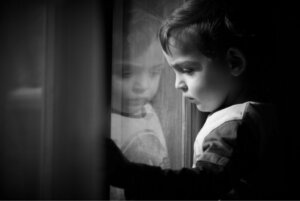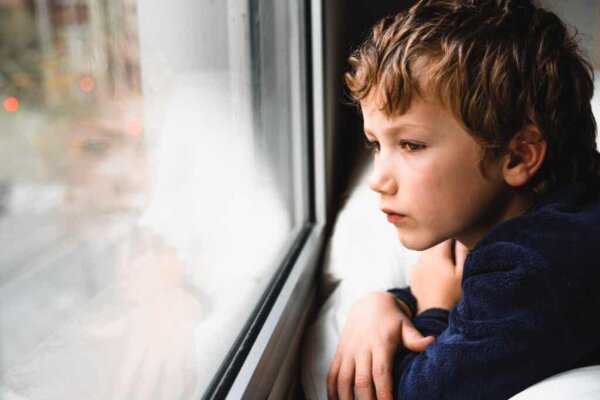Childhood Trauma Shows Up On Brain Scans


Written and verified by the psychologist Valeria Sabater
Neuroimaging technology is making key discoveries in medicine and psychology. For example, neuroscientists have discovered that childhood trauma shows up on brain scans. This is probably because it touches both large and small neural areas and leaves subtle alterations that completely undermine the individual’s well-being.
A childhood of abuse leaves huge scars. However, abuse in the form of yelling or neglect, beatings, emotional emptiness, and the persistent shadow of fear doesn’t only lay the foundations for post-traumatic stress. In fact, it’s now clear that a child abused between the ages of four and seven has a shorter life expectancy.
Furthermore, scientists discovered that this section of the population has a higher risk of experiencing all kinds of conditions. These can range from diabetes to cardiovascular diseases. Nevertheless, despite these rather shocking facts, there is some hope. In fact, these types of discoveries allow the medical field to develop more effective approaches with which to improve the lives of those affected.
The term “trauma” comes from Greek; it means wound. These early experiences certainly disrupt a child’s optimal development and affect their mental health. However, there are many strategies available to deal with it. Indeed, trauma doesn’t have to last a lifetime.
“The greater a child’s terror, and the earlier it is experienced, the harder it becomes to develop a strong and healthy sense of self.”
-Nathaniel Branden-

Childhood trauma shows up on brain scans
The high rate of major depression evident in adulthood is just one example of how traumatic experiences engrave the young brain. This psychological disorder develops in these patients in a particular way. In fact, it’s more persistent and there are observable alterations in the brain structure.
In these cases, before reaching a more serious depressive disorder between 20 and 30 years of age, the individual will have endured a whole series of problems from childhood through to adolescence. These manifest as lack of concentration, academic delays, sleep disturbances, hyperactivity, impulse control problems, somatic illnesses, and self-injurious behaviors, etc.
These people tend to assume that no one can understand their pain. They believe that life only leads to suffering; that it won’t be easy to find someone who’ll truly love them, and that the world is a harmful place. As you can see, these persistent feelings of loneliness and helplessness are their psychic wound speaking. They’re the echo of the trauma lodged in their deepest brain structures.
Childhood trauma interferes with brain development
Trauma shows up on brain scans and experts are now able to see it in more detail. For instance, just a few months ago, the University of Alberta in Canada presented an interesting study on this topic. The one thing they concluded is that traumatic experiences between the ages of four and seven impair normal brain development.
These small alterations make people more vulnerable to developing anxiety, post-traumatic stress, depression, lack of impulse control, poor emotional management, etc. However, this isn’t a determining factor in 100 percent of the cases, it’s only a risk variable.
Scientists have also observed that there are deficits of serotonin and norepinephrine transmitters in sufferers. This translates into a greater reactivity to fear, worry and uncertainty. Furthermore, this type of person is more prone to experience distress, which in turn reactivates the memory of their traumatic experiences.
The amygdala and hippocampus are the most affected areas
The University of Alberta research team was also able to see how the hippocampus and the amygdala were the most affected regions. Thus, the first thing that’s seen when childhood trauma shows up on brain scans is an alteration in the volume of these areas. They’re smaller.
The hippocampus and amygdala are related to emotion and memory. Therefore, people who’ve been through early traumatic experiences show difficulties in processing fear, sadness, and conflicts.
In addition, the variations in the volume of these regions also translate into blockages when solving problems. There’s also a greater tendency to impulsive behavior. In fact, there are often risky behaviors like substance abuse, involvement in harmful emotional relationships, etc.
Traumatized children experience distress because they lack support and physical and emotional protection from others. It translates into a constant fear that alters the brain structure. Consequently, it may lead to major depression in the future.

Future treatment
Research conducted by Stanford University and published in the journal Nature found that more than 62 percent of people with major depression had also experienced some form of trauma in their childhood. Among this group, those who had these types of experiences earlier on in their lives didn’t respond to treatments such as sertraline (an antidepressant).
Now that experts are aware that childhood trauma appears in brain scans, they’re able to study sufferers individually and prescribe certain medications. For example, they’ve discovered that these experiences often slow down the growth of the basolateral amygdala. This results in anxious behavior. In these cases, an alternative drug to sertraline in combination with a specific and targeted psychological therapy is often a good idea.
At the moment, it isn’t common for every patient who experienced trauma in childhood to undergo MRI scans. However, it may soon become an essential way for deciding on the most suitable therapeutic approach to adopt.
Neuroimaging technology is making key discoveries in medicine and psychology. For example, neuroscientists have discovered that childhood trauma shows up on brain scans. This is probably because it touches both large and small neural areas and leaves subtle alterations that completely undermine the individual’s well-being.
A childhood of abuse leaves huge scars. However, abuse in the form of yelling or neglect, beatings, emotional emptiness, and the persistent shadow of fear doesn’t only lay the foundations for post-traumatic stress. In fact, it’s now clear that a child abused between the ages of four and seven has a shorter life expectancy.
Furthermore, scientists discovered that this section of the population has a higher risk of experiencing all kinds of conditions. These can range from diabetes to cardiovascular diseases. Nevertheless, despite these rather shocking facts, there is some hope. In fact, these types of discoveries allow the medical field to develop more effective approaches with which to improve the lives of those affected.
The term “trauma” comes from Greek; it means wound. These early experiences certainly disrupt a child’s optimal development and affect their mental health. However, there are many strategies available to deal with it. Indeed, trauma doesn’t have to last a lifetime.
“The greater a child’s terror, and the earlier it is experienced, the harder it becomes to develop a strong and healthy sense of self.”
-Nathaniel Branden-

Childhood trauma shows up on brain scans
The high rate of major depression evident in adulthood is just one example of how traumatic experiences engrave the young brain. This psychological disorder develops in these patients in a particular way. In fact, it’s more persistent and there are observable alterations in the brain structure.
In these cases, before reaching a more serious depressive disorder between 20 and 30 years of age, the individual will have endured a whole series of problems from childhood through to adolescence. These manifest as lack of concentration, academic delays, sleep disturbances, hyperactivity, impulse control problems, somatic illnesses, and self-injurious behaviors, etc.
These people tend to assume that no one can understand their pain. They believe that life only leads to suffering; that it won’t be easy to find someone who’ll truly love them, and that the world is a harmful place. As you can see, these persistent feelings of loneliness and helplessness are their psychic wound speaking. They’re the echo of the trauma lodged in their deepest brain structures.
Childhood trauma interferes with brain development
Trauma shows up on brain scans and experts are now able to see it in more detail. For instance, just a few months ago, the University of Alberta in Canada presented an interesting study on this topic. The one thing they concluded is that traumatic experiences between the ages of four and seven impair normal brain development.
These small alterations make people more vulnerable to developing anxiety, post-traumatic stress, depression, lack of impulse control, poor emotional management, etc. However, this isn’t a determining factor in 100 percent of the cases, it’s only a risk variable.
Scientists have also observed that there are deficits of serotonin and norepinephrine transmitters in sufferers. This translates into a greater reactivity to fear, worry and uncertainty. Furthermore, this type of person is more prone to experience distress, which in turn reactivates the memory of their traumatic experiences.
The amygdala and hippocampus are the most affected areas
The University of Alberta research team was also able to see how the hippocampus and the amygdala were the most affected regions. Thus, the first thing that’s seen when childhood trauma shows up on brain scans is an alteration in the volume of these areas. They’re smaller.
The hippocampus and amygdala are related to emotion and memory. Therefore, people who’ve been through early traumatic experiences show difficulties in processing fear, sadness, and conflicts.
In addition, the variations in the volume of these regions also translate into blockages when solving problems. There’s also a greater tendency to impulsive behavior. In fact, there are often risky behaviors like substance abuse, involvement in harmful emotional relationships, etc.
Traumatized children experience distress because they lack support and physical and emotional protection from others. It translates into a constant fear that alters the brain structure. Consequently, it may lead to major depression in the future.

Future treatment
Research conducted by Stanford University and published in the journal Nature found that more than 62 percent of people with major depression had also experienced some form of trauma in their childhood. Among this group, those who had these types of experiences earlier on in their lives didn’t respond to treatments such as sertraline (an antidepressant).
Now that experts are aware that childhood trauma appears in brain scans, they’re able to study sufferers individually and prescribe certain medications. For example, they’ve discovered that these experiences often slow down the growth of the basolateral amygdala. This results in anxious behavior. In these cases, an alternative drug to sertraline in combination with a specific and targeted psychological therapy is often a good idea.
At the moment, it isn’t common for every patient who experienced trauma in childhood to undergo MRI scans. However, it may soon become an essential way for deciding on the most suitable therapeutic approach to adopt.
All cited sources were thoroughly reviewed by our team to ensure their quality, reliability, currency, and validity. The bibliography of this article was considered reliable and of academic or scientific accuracy.
- De Bellis, M. D., & Zisk, A. (2014). The biological effects of childhood trauma. Child and adolescent psychiatric clinics of North America, 23(2), 185–vii. https://doi.org/10.1016/j.chc.2014.01.002
- Meichen Yu, Kristin A. Linn, Russell T. Shinohara, Desmond J. Oathes, Philip A. Cook, Romain Duprat (2020) Childhood trauma history is linked to abnormal brain connectivity in major depression. Proceedings of the National Academy of Sciences Apr 2019, 116 (17) 8582-8590; DOI: 10.1073/pnas.1900801116
- Williams, L., Debattista, C., Duchemin, AM. et al. Childhood trauma predicts antidepressant response in adults with major depression: data from the randomized international study to predict optimized treatment for depression. Transl Psychiatry 6, e799 (2016). https://doi.org/10.1038/tp.2016.61
This text is provided for informational purposes only and does not replace consultation with a professional. If in doubt, consult your specialist.







